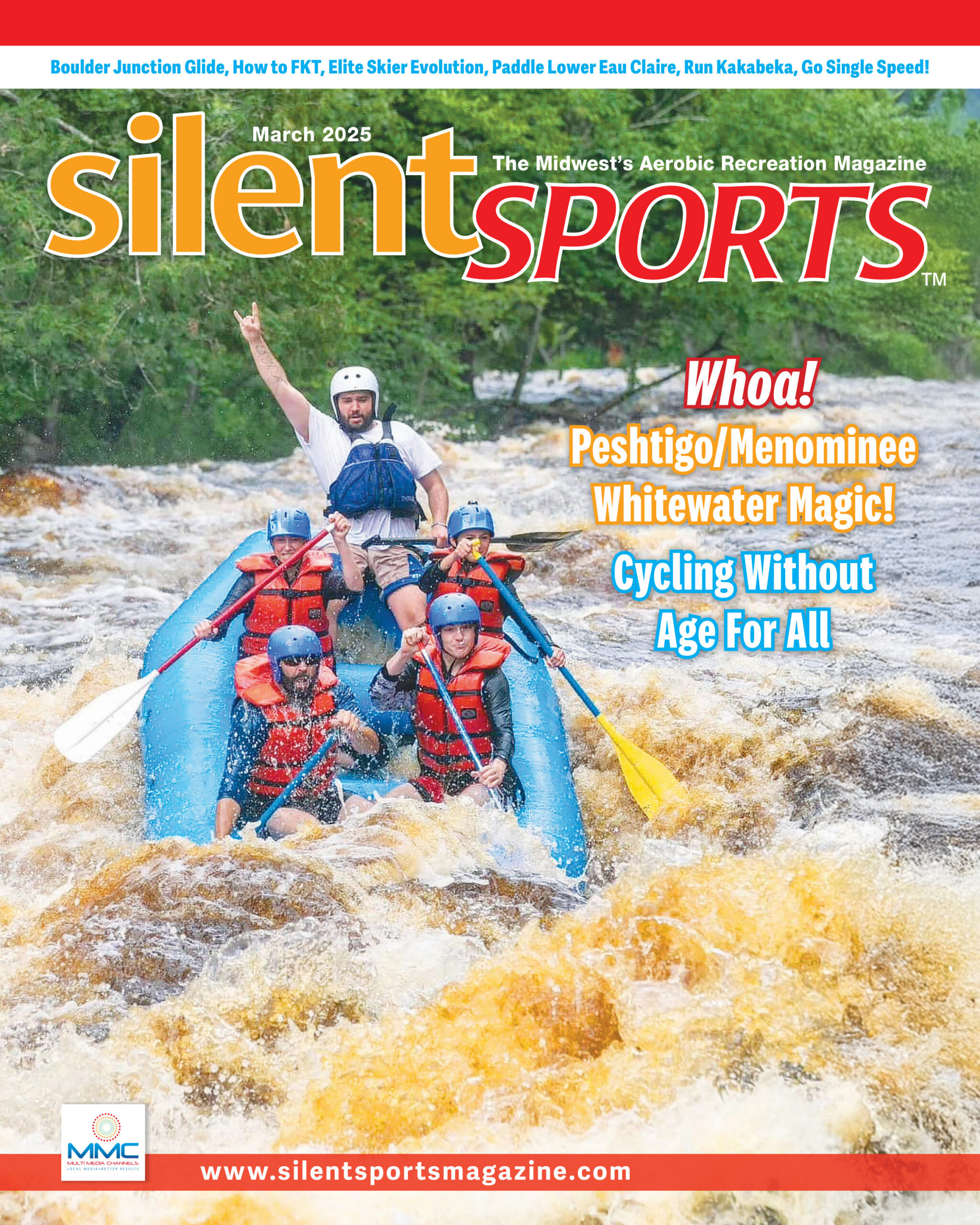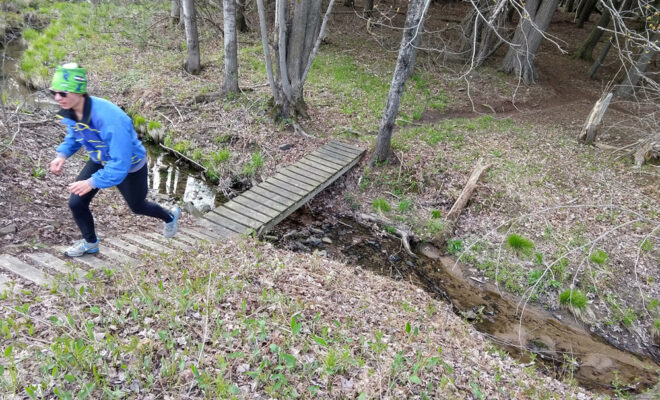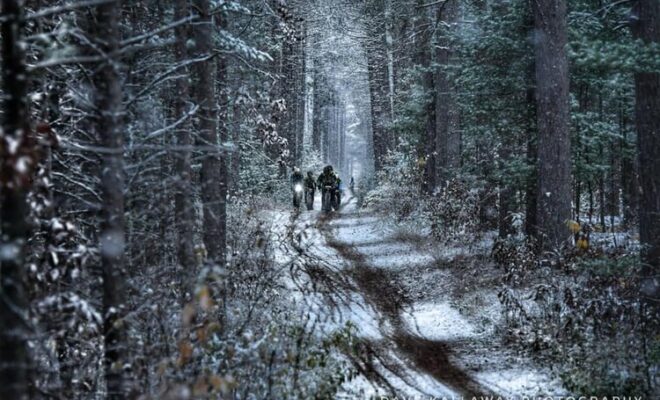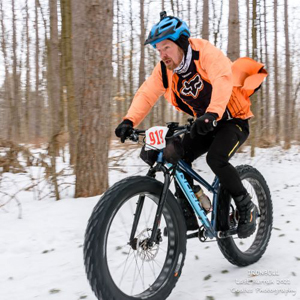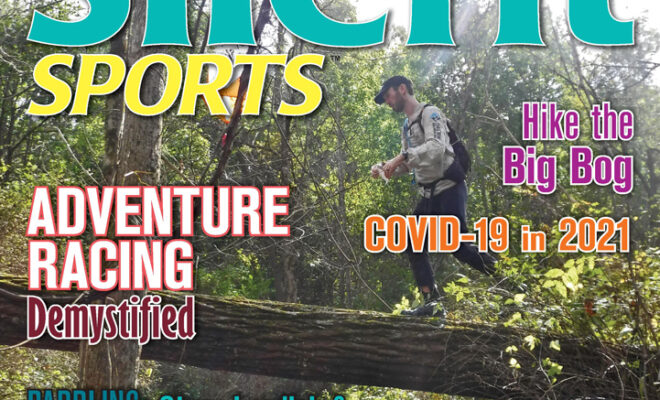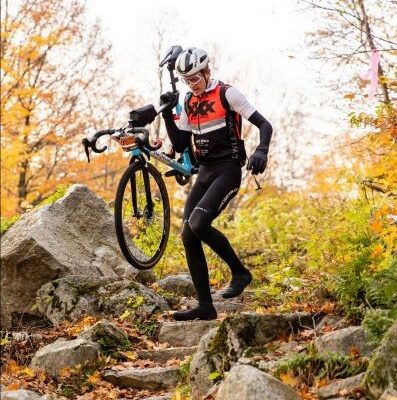Adventure Racing, Part 1: Demystifying the Race
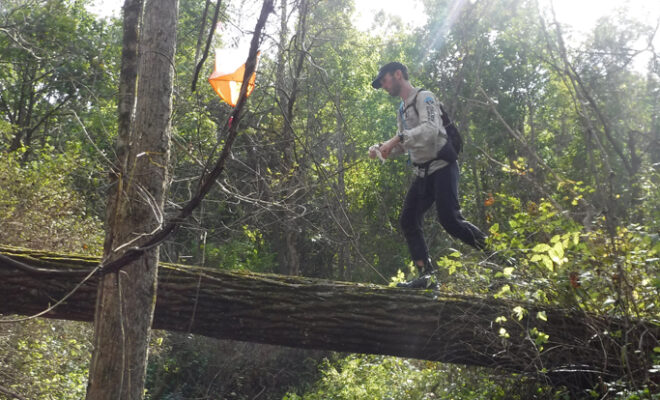
By Andrea Larson
[Please add your thoughts about this story by scrolling way (way) down to the comments box. Thank you!]
Editor’s Note: Andrea Larson has been a three-sport walk-on collegiate competitor, an ultra-marathon race course record-holder, with wins in triathlon, Nordic skiing, and even a 24-hour solo mountain bike race. Going from chemical engineering to director of IRONBULL, improving silent sports in the Wausau area, she is also a wife and mother and, by the way, a member of the championship adventure racing team that will be the subject of Part 2, written by Chris Schotz.
Adventure racing is exactly that: there is no cookie-cutter race course. Every event has its own, specifically designed race course for that event, and every team can create a different route through the race course.
How?
Adventure race courses are unmarked. Teams must find checkpoints using a map and compass. No GPS allowed. A checkpoint is typically an orienteering marker usually hung in a tree with a unique hole punch. Teams punch a passport, provided by the race director, to prove they were at the checkpoint. Sometimes it can be an electronic punch, or sometimes racers write down an answer to a question, such as how many holes in the birdhouse?
It’s All Part of the Adventure
Racers may have to bike, bushwhack, paddle, or complete a special challenge to get from checkpoint to checkpoint. This is explained in instructions racers receive when they arrive at the event, or sometimes not until racers arrive at that section of the course.

Adventure racers often go off the beaten path and experience hidden gems. Team Rib Mountain Racing at the Stubborn Fool at Devil’s Lake State Park, with navigator Tim Buchholz leading teammate Erik Martinez. Photo credit: Andrea Larson. (Click on each photo to enlarge.)
Once again, part of the unique adventure in adventure racing.
Many times, checkpoints are located on scenic vistas, along pristine waterways, or at other interesting features. Teams often must go off-trail to find checkpoints, allowing racers to experience a park in a new and different perspective. In this way, an adventure race feels like a self-guided tour.
You got it—more adventure.
Race directors locate checkpoints strategically, to ensure racers move through the course in a certain manner. For instance, even though a main roadway may be the shortest distance between two parks, the race director may place a checkpoint on a less-traveled road. This is necessary since the course remains open to traffic, other trail users, and boaters.
The length of the course is ultimately dependent on the team. Teams have been known to add many miles circling looking for a checkpoint. But what is known (finally, something known!) is that racers must arrive at the finish line by a set time, or face a penalty. That is why racers register for a set-hour race, so they know they should not be racing beyond that duration.
In order for slower teams, especially beginners, to get to the finish area by the required time limit, skipping checkpoints or sections may be necessary. Sometimes, even the fastest teams fail to clear the course. (See sidebar on adventure racing terminology.) Race directors may also employ required checkpoints or cut-off times to ensure all teams keep moving along a course, especially in point-to-point courses. Courses may be point-to-point, a single loop, or multiloop. Once racers arrive at race headquarters, they may be shuttled from there to the actual start line on race day, meaning a point-to-point course.
See an adventurous trend here yet?
Racers are responsible for their gear, food, and sometimes hydration for the duration of the race. To prepare racers, race directors provide lists of required and recommended gear. Several items are mandatory, such as: compass, mountain bike, bike helmet, first-aid kit, writing utensil, and cellphone for emergency calls. Race directors also usually recommend items such as bike tools, long pants, and duct tape. All maps and usually boats are provided.
Teamwork and the Human Element
With all its many variables, adventure racing also brings in the unpredictability of people. Some events allow solo racers, since adventure racing is not a relay, but most racers compete on teams. Racers remain alongside teammates throughout the race, which provides a unique aspect of allowing teammates to share the entire experience together.

Teams must paddle, bike, and trek to checkpoints, often denoted by a white and orange orienteering flag, along the course. Rebecca Tuley (left) and Chris Schotz (right) in the 8-hour Rib Mountain Adventure Challenge, the largest adventure race in the United States Adventure Racing Association Series. Photo credit: Ann Illagan Photography
On a team, each teammate has an established role. The lead navigator is in charge of the map. One teammate will typically carry and punch the passport at checkpoints while the navigator consults the map for a route to the next checkpoint. Sometimes the navigator will ask another team member to pace count. (See sidebar.) All teammates must assist each other to collectively move together —in nearly every race, one teammate will carry gear for another teammate.
Once, I had my pedal snap off my bike. Although this could have been catastrophic, most teams prepare for such obstacles by assembling teammates with positive attitudes, and bringing helpful gear which, in this case, was a tow system. (See Adventure Racing Terminology, below.)
If reading a map is not your strength, you can still adventure race. You can rely on a teammate who can handle this role, and you learn as you go, especially if it’s a beginner-friendly course. If you have limited paddling experience, share a boat with a teammate who can steer the boat. Not a strong runner? Don’t worry because even the best teams walk a significant amount of time.
Atypical is typical with adventure racers. We come from all backgrounds. What you can count on with adventure racing is this: No matter your age, you will improve as you gain experience.
Special Challenges and More
Racers don’t know what the special challenge in a race is until they show up. Special challenges in adventure races include: Bouldering, dodgeball, gunnysack races, rollerblading, archery, puzzles, blind rear tire bike removal, or perhaps birdhouse assembly.

Left to right: Story contributor Andrea Larson, Rib Mountain Racing Team captain Tim Buccholz, and Erik Martinez. Special challenges could include anything including assembling a bird house mid-race. At the Milwaukee Area Fall Frenzy (Andreas first adventure race). Photo courtesy of Timothy Buchholz.
Adventure races span from a few hours to overnight to multi-day. Although a 3-hour duration may sound challenging, it’s doable for recreational participants.
The longer duration of adventure races as compared to most other sports’ races exists because adventure racers move much slower over unmarked courses. Also, they race as a team so they stay together. Teams move as fast as their slowest teammate, and the race is multi-disciplinary, which also requires transition time.
In a 3-hour adventure race, participants can expect to cover about 5K on foot, 15K biking, and 5K paddling.
Community
The adventure racing community prides itself on the integrity of the sport. Not just their tenacity, but also their sportsmanship. Hardly a race goes by where there is not another team coming to the aid of another.
Nearly every race ends with a post-race meal where, over a beer, racers exchange stories about their day’s adventures.
Combine your silent sports; dare for something unique, fun, and challenging. Be adventurous with this community now. The stories you’ll share will be like no other.
See you on the next adventure!
Reach Andrea Larson at: [email protected]
≈
Adventure Racing Terminology
Bearing: Using a compass to determine direction of travel.
Checkpoint (CP): What orienteering marker teams must navigate to. Races typically have between 12 to 80 checkpoints.
Clear the Course: When a team finds all checkpoints within the designated time allowance. Sometimes not a single team will clear the course.

Timothy Buchholz out on a limb for a checkpoint at the 2018 Code Blue Challenge 12-hour Adventure Race. Photo by Anna Nummelin.
E-Punch: An electronic device scanned at each checkpoint to prove a team was there.
Gear list: An equipment-required-or-recommended list provided by the race director, designating gear for a specific race that a team must carry.
Hike-a-Bike (or Bike–whack): Sections in which teams carry or push a bike rather than ride; usually chosen to create a much shorter route over biking.
Map Board: A device fixed to a bike’s handlebars to enable the team’s navigator to read the map while biking.
Navigator: The person on a team responsible for reading the map, who leads the team to checkpoints.
On Tow: A person being pulled by another teammate using a device such as a bungee cord.
Open Course: Race routes that remain open to the public, including traffic, trail users, and boaters.
Orienteering: Using a map and compass to navigate to course checkpoints.
Pace Count: Using calibrated footsteps to gauge distance traveled since GPS devices are not allowed.
Passport: A paper, typically waterproof, with boxes teams punch using a unique hole punch located at every checkpoint, to prove they were there.
Topo: Short for “topography.” The means with which teams navigate the course.
Tow System: Gear enabling a faster teammate to pull a slower teammate during biking or foot sections.
Transition Area (TA): Point on the course where racers change disciplines, such as from biking to paddling.
Trek: Foot section(s) which may consist of road and trail running, hiking/walking, and/or bushwhacking.
You can subscribe and receive your print copy of Silent Sports Magazine AND have unlimited access to online stories @ www.SilentSportsMagazine.Com for under $2 per issue by contacting Lynn Schoohs: [email protected] or 715-258-4360, or online via: https://www.shopmmclocal.com/product/silent-sports-magazine/

